Genetic Analysis of Soybean Flower Size Phenotypes Based on Computer Vision and Genome-Wide Association Studies
Abstract
:1. Introduction
2. Results
2.1. Phenotypic Correlation Analysis
2.2. Petal and Seed Trait GWASs
2.3. Interaction Analysis of Significant SNPs between Soybean Seeds and Petal GWAS Results
2.4. Candidate Gene Identification of Vexil and Wing Traits
2.5. Haplotype Analysis of Candidate Genes
2.6. Population Genetics Analysis of Candidate Genes
3. Discussion
3.1. Phenome and Genome Analyses Unveiled Genetic Loci Associated with Flower Organ Size in Soybeans
3.2. Genes That Promote Organ Development Play a Crucial Role in Regulating Soybean Yield Positively
3.3. Exploration and Analysis of the General Law of Petal Size and Grain Size of Leguminous Plants
3.4. The Combination of Computer Vision and the GWAS Brings a New Perspective and Application for Smart Breeding
4. Materials and Methods
4.1. Material Planting
4.2. Genotype Data Acquisition
4.3. Phenotype Acquisition
4.4. Data Extraction Based on Computer Vision
4.5. Analysis of Relationship
4.6. Genome-Wide Association Studies
4.7. Candidate Gene Identification
4.8. Haplotype Analysis and Screening
4.9. Genetic Analysis of Gene Population
4.10. SNP Interaction Analysis and Transcriptome Analysis
Supplementary Materials
Author Contributions
Funding
Institutional Review Board Statement
Informed Consent Statement
Data Availability Statement
Conflicts of Interest
References
- Li, Y.H.; Reif, J.C.; Hong, H.L.; Li, H.H.; Liu, Z.X.; Ma, Y.S.; Li, J.; Tian, Y.; Li, Y.F.; Li, W.B.; et al. Genome-wide association mapping of QTL underlying seed oil and protein contents of a diverse panel of soybean accessions. Plant Sci. 2018, 266, 95–101. [Google Scholar] [CrossRef] [PubMed]
- Hymowitz, T.; Collins, F.I.; Panczner, J.; Walker, W.M. Relationship Between the Content of Oil, Protein, and Sugar in Soybean Seed. Agron. J. 1972, 66, 613–616. [Google Scholar] [CrossRef]
- Jiang, G.L.; Chen, P.Y.; Zhang, J.P.; Florez-Palacios, L.; Zeng, A.L.; Wang, X.Z.; Bowen, R.A.; Miller, A.; Berry, H. Genetic Analysis of Sugar Composition and Its Relationship with Protein, Oil, and Fiber in Soybean. Crop Sci. 2018, 58, 2413–2421. [Google Scholar] [CrossRef]
- Graham, P.H.; Vance, C.P. Legumes: Importance and constraints to greater use. Plant Physiol. 2003, 131, 872–877. [Google Scholar] [CrossRef] [PubMed]
- Johnson, K.; Lenhard, M. Genetic control of plant organ growth. New Phytol. 2011, 191, 319–333. [Google Scholar] [CrossRef] [PubMed]
- Sussex, T.A.; Ian, M. Patterns in Plant Development; Cambridge University Press: Cambridge, UK, 1972. [Google Scholar]
- Feng, G.P.; Qin, Z.X.; Yan, J.Z.; Zhang, X.R.; Hu, Y.X. Arabidopsis ORGAN SIZE RELATED1 regulates organ growth and final organ size in orchestration with ARGOS and ARL. New Phytol. 2011, 191, 635–646. [Google Scholar] [CrossRef] [PubMed]
- Li, S.J.; Liu, Y.J.; Zheng, L.Y.; Chen, L.L.; Li, N.; Corke, F.; Lu, Y.R.; Fu, X.D.; Zhu, Z.G.; Bevan, M.W.; et al. The plant-specific G protein? subunit AGG3 influences organ size and shape in Arabidopsis thaliana. New Phytol. 2012, 194, 690–703. [Google Scholar] [CrossRef] [PubMed]
- Dafni, A.; Kevan, P.G. Flower size and shape: Implications in pollination. Isr. J. Plant Sci. 1997, 45, 201–211. [Google Scholar] [CrossRef]
- Shpak, E.D.; Berthiaume, C.T.; Hill, E.J.; Torii, K.U. Synergistic interaction of three ERECTA-family receptor-like kinases controls Arabidopsis organ growth and flower development by promoting cell proliferation. Development 2004, 131, 1491–1501. [Google Scholar] [CrossRef]
- Song, P.; Wang, J.L.; Guo, X.Y.; Yang, W.N.; Zhao, C.J. High-throughput phenotyping: Breaking through the bottleneck in future crop breeding. Crop J. 2021, 9, 633–645. [Google Scholar] [CrossRef]
- Patrício, D.I.; Rieder, R. Computer vision and artificial intelligence in precision agriculture for grain crops: A systematic review. Comput. Electron. Agric. 2018, 153, 69–81. [Google Scholar] [CrossRef]
- Affortit, P.; Effa-Effa, B.; Ndoye, M.S.; Moukouanga, D.; Luchaire, N.; Cabrera-Bosquet, L.; Perálvarez, M.; Pilloni, R.; Welcker, C.; Champion, A.; et al. Physiological and genetic control of transpiration efficiency in African rice, Oryza glaberrima Steud. J. Exp. Bot. 2022, 73, 5279–5293. [Google Scholar] [CrossRef]
- Guo, S.J.; Zhou, G.L.; Wang, J.L.; Lu, X.J.; Zhao, H.; Zhang, M.G.; Guo, X.Y.; Zhang, Y. High-Throughput Phenotyping Accelerates the Dissection of the Phenotypic Variation and Genetic Architecture of Shank Vascular Bundles in Maize (Zea mays L.). Plants 2022, 11, 1339. [Google Scholar] [CrossRef] [PubMed]
- Nagle, M.F.; Yuan, J.L.; Kaur, D.; Ma, C.; Peremyslova, E.; Jiang, Y.; de Rivera, A.N.; Jawdy, S.; Chen, J.G.; Feng, K.; et al. GWAS supported by computer vision identifies large numbers of candidate regulators of in planta regeneration in Populus trichocarpa. G3-Genes Genomes Genet. 2024, 14, jkae026. [Google Scholar] [CrossRef] [PubMed]
- Mizukami, Y.; Fischer, R.L. Plant organ size control: AINTEGUMENTA regulates growth and cell numbers during organogenesis. Proc. Natl. Acad. Sci. USA 2000, 97, 942–947. [Google Scholar] [CrossRef] [PubMed]
- Zhou, S.; Yang, T.; Mao, Y.; Liu, Y.; Chen, J. The F-box protein MIO1/SLB1 regulates organ size and leaf movement in Medicago truncatula. J. Exp. Bot. 2021, 72, 2995–3011. [Google Scholar] [CrossRef] [PubMed]
- Dehghan, A. Genome-Wide Association Studies. Methods Mol. Biol. 2018, 1793, 37–49. [Google Scholar] [PubMed]
- Thomson, M.J. High-Throughput SNP Genotyping to Accelerate Crop Improvement. Plant Breed. Biotechnol. 2014, 2, 195–212. [Google Scholar] [CrossRef]
- Korte, A.; Farlow, A. The advantages and limitations of trait analysis with GWAS: A review. Plant Methods 2013, 9, 29. [Google Scholar] [CrossRef]
- Ibrahim, A.K.; Zhang, L.W.; Niyitanga, S.; Afzal, M.Z.; Xu, Y.; Zhang, L.L.; Zhang, L.M.; Qi, J.M. Principles and approaches of association mapping in plant breeding. Trop. Plant Biol. 2020, 13, 212–224. [Google Scholar] [CrossRef]
- Tian, F.; Bradbury, P.J.; Brown, P.J.; Hung, H.; Sun, Q.; Flint-Garcia, S.; Rocheford, T.R.; McMullen, M.D.; Holland, J.B.; Buckler, E.S. Genome-wide association study of leaf architecture in the maize nested association mapping population. Nat. Genet. 2011, 43, 159–162. [Google Scholar] [CrossRef] [PubMed]
- Huang, X.H.; Wei, X.H.; Sang, T.; Zhao, Q.A.; Feng, Q.; Zhao, Y.; Li, C.Y.; Zhu, C.R.; Lu, T.T.; Zhang, Z.W.; et al. Genome-wide association studies of 14 agronomic traits in rice landraces. Nat. Genet. 2010, 42, 961–967. [Google Scholar] [CrossRef] [PubMed]
- Zhang, J.P.; Song, Q.J.; Cregan, P.B.; Nelson, R.L.; Wang, X.Z.; Wu, J.X.; Jiang, G.L. Genome-wide association study for flowering time, maturity dates and plant height in early maturing soybean (Glycine max) germplasm. BMC Genom. 2015, 16, 217. [Google Scholar] [CrossRef] [PubMed]
- Lin, F.; Wani, S.H.; Collins, P.J.; Wen, Z.X.; Li, W.L.; Zhang, N.; McCoy, A.G.; Bi, Y.D.; Tan, R.J.; Zhang, S.C.; et al. QTL mapping and GWAS for identification of loci conferring partial resistance to Pythium sylvaticum in soybean (Glycine max (L.) Merr). Mol. Breed. 2020, 40, 54. [Google Scholar] [CrossRef]
- Zhang, J.P.; Song, Q.J.; Cregan, P.B.; Jiang, G.L. Genome-wide association study, genomic prediction and marker-assisted selection for seed weight in soybean (Glycine max). Theor. Appl. Genet. 2016, 129, 117–130. [Google Scholar] [CrossRef] [PubMed]
- Wu, C.J.; Mozzoni, L.A.; Moseley, D.; Hummer, W.; Ye, H.; Chen, P.Y.; Shannon, G.; Nguyen, H. Genome-wide association mapping of flooding tolerance in soybean. Mol. Breed. 2019, 40, 4. [Google Scholar] [CrossRef]
- Li, D.M.; Zhao, X.; Han, Y.P.; Li, W.B.; Xie, F.T. Genome-wide association mapping for seed protein and oil contents using a large panel of soybean accessions. Genomics 2019, 111, 90–95. [Google Scholar] [CrossRef] [PubMed]
- Do, T.D.; Vuong, T.D.; Dunn, D.; Clubb, M.; Valliyodan, B.; Patil, G.; Chen, P.Y.; Xu, D.; Nguyen, H.T.; Shannon, J.G. Identification of new loci for salt tolerance in soybean by high-resolution genome-wide association mapping. BMC Genom. 2019, 20, 318. [Google Scholar] [CrossRef]
- Du, W.K.; Ning, L.H.; Liu, Y.S.; Zhang, S.X.; Yang, Y.M.; Wang, Q.; Chao, S.Q.; Yang, H.; Huang, F.; Cheng, H.; et al. Identification of loci and candidate gene GmSPX-RING1 responsible for phosphorus efficiency in soybean via genome-wide association analysis. BMC Genom. 2020, 21, 725. [Google Scholar] [CrossRef]
- Chang, F.G.; Lv, W.H.; Lv, P.Y.; Xiao, Y.T.; Yan, W.L.; Chen, S.; Zheng, L.Y.; Xie, P.; Wang, L.; Karikari, B.; et al. Exploring genetic architecture for pod-related traits in soybean using image-based phenotyping. Mol. Breed. 2021, 41, 28. [Google Scholar] [CrossRef]
- Hao, D.; Cheng, H.; Yin, Z.; Cui, S.; Zhang, D.; Yu, W.D. Identification of single nucleotide polymorphisms and haplotypes associated with yield and yield components in soybean (Glycine max) landraces across multiple environments. TAG Theor. Appl. Genet. 2012, 124, 447–458. [Google Scholar] [CrossRef]
- Matsuda, H.; Nakayasu, M.; Aoki, Y.; Yamazaki, S.; Nagano, A.J.; Yazaki, K.; Sugiyama, A. Diurnal metabolic regulation of isoflavones and soyasaponins in soybean roots. Plant Direct 2020, 4, e00286. [Google Scholar] [CrossRef] [PubMed]
- Bobo, E.; Munosiyei, P.; Jinga, P.; Zingoni, E. Functional Characterisation of a Calmodulin-Binding Receptor-Like Cytoplasmic Kinase (GmCBRLCK1) in Glycine max (L.) Merr. using Bioinformatic Tools. Int. Ann. Sci. 2019, 7, 38–47. [Google Scholar] [CrossRef]
- Du, J.; Wang, S.D.; He, C.M.; Zhou, B.; Ruan, Y.L.; Shou, H.X. Identification of regulatory networks and hub genes controlling soybean seed set and size using RNA sequencing analysis. J. Exp. Bot. 2017, 68, 1955–1972. [Google Scholar] [CrossRef] [PubMed]
- Chen, Q.; Liu, B.Q.; Ai, L.J.; Yan, L.; Lin, J.; Shi, X.L.; Zhao, H.T.; Wei, Y.; Feng, Y.; Liu, C.J.; et al. QTL and candidate genes for heterophylly in soybean based on two populations of recombinant inbred lines. Front. Plant Sci. 2022, 13, 961619. [Google Scholar] [CrossRef] [PubMed]
- Van den Oord, E.; Neale, B. Will haplotype maps be useful for finding genes? Mol. Psychiatry 2004, 9, 227–236. [Google Scholar] [CrossRef] [PubMed]
- Poland, J.A.; Bradbury, P.J.; Buckler, E.S.; Nelson, R.J. Genome-wide nested association mapping of quantitative resistance to northern leaf blight in maize. Proc. Natl. Acad. Sci. USA 2011, 108, 6893–6898. [Google Scholar] [CrossRef] [PubMed]
- Bheemanahalli, R.; Wang, C.X.; Bashir, E.; Chiluwal, A.; Pokharel, M.; Perumal, R.; Moghimi, N.; Ostmeyer, T.; Caragea, D.; Jagadish, S.V.K. Classical phenotyping and deep learning concur on genetic control of stomatal density and area in sorghum. Plant Physiol. 2021, 186, 1562–1579. [Google Scholar] [CrossRef] [PubMed]
- Hu, Z.B.; Zhang, H.R.; Kan, G.Z.; Ma, D.Y.; Zhang, D.; Shi, G.X.; Hong, D.L.; Zhang, G.Z.; Yu, D.Y. Determination of the genetic architecture of seed size and shape via linkage and association analysis in soybean (Glycine max L. Merr.). Genetica 2013, 141, 247–254. [Google Scholar] [CrossRef] [PubMed]
- Mansur, L.M.; Lark, K.G.; Kross, H.; Oliveira, A. Interval mapping of quantitative trait loci for reproductive, morphological, and seed traits of soybean (Glycine max L.). Theor. Appl. Genet. 1993, 86, 907–913. [Google Scholar] [CrossRef]
- Wang, D.; Graef, G.L.; Procopiuk, A.M.; Diers, B.W. Identification of putative QTL that underlie yield in interspecific soybean backcross populations. Theor. Appl. Genet. 2004, 108, 458–467. [Google Scholar] [CrossRef] [PubMed]
- Gonzalez, N.; Vanhaeren, H.; Inzé, D. Leaf size control: Complex coordination of cell division and expansion. Trends Plant Sci. 2012, 17, 332–340. [Google Scholar] [CrossRef] [PubMed]
- Klein, J.; Saedler, H.; Huijser, P. A new family of DNA binding proteins includes putative transcriptional regulators of the Antirrhinum majus floral meristem identity gene SQUAMOSA. Mol. Gen. Genet. 1996, 250, 7–16. [Google Scholar] [PubMed]
- Becraft, P.W.; Bongard-Pierce, D.K.; Sylvester, A.W.; Poethig, R.S.; Freeling, M. The liguleless-1 gene acts tissue specifically in maize leaf development. Dev. Biol. 1990, 141, 220–232. [Google Scholar] [CrossRef] [PubMed]
- Cardon, G.H.; Hohmann, S.; Nettesheim, K.; Saedler, H.; Huijser, P. Functional analysis of the Arabidopsis thaliana SBP-box gene SPL3: A novel gene involved in the floral transition. Plant J. Cell Mol. Biol. 1997, 12, 367–377. [Google Scholar] [CrossRef] [PubMed]
- Cardon, G.; Höhmann, S.; Klein, J.; Nettesheim, K.; Saedler, H.; Huijser, P. Molecular characterisation of the Arabidopsis SBP-box genes. Gene 1999, 237, 91. [Google Scholar] [CrossRef]
- Lännenpää, M.; Jänönen, I.; Hölttä-Vuori, M.; Gardemeister, M.M.; Sopanen, T. A new SBP-box gene BpSPL1 in silver birch (Betula pendula). Physiol. Plant. 2010, 120, 491–500. [Google Scholar] [CrossRef]
- Schmid, M.; Uhlenhaut, N.H.; Godard, F.; Demar, M.; Bressan, R.; Weigel, D.; Lohmann, J.U. Dissection of floral induction pathways using global expression analysis. Development 2003, 130, 6001–6012. [Google Scholar] [CrossRef] [PubMed]
- Unte, U.S.; Sorensen, A.M.; Pesaresi, P.; Gandikota, M.; Leister, D.; Saedler, H.; Huijser, P. SPL8, an SBP-Box gene that affects pollen sac development in Arabidopsis. Plant Cell 2003, 15, 1009–1019. [Google Scholar] [CrossRef] [PubMed]
- Breuninger, H.; Lenhard, M. Control of Tissue and Organ Growth in Plants. Curr. Top. Dev. Biol. 2010, 91, 185–220. [Google Scholar]
- Mizukami, Y. A matter of size: Developmental control of organ size in plants. Curr. Opin. Plant Biol. 2001, 4, 533–539. [Google Scholar] [CrossRef]
- Tombuloglu, G.; Aldahnem, A.; Tombuloglu, H.; Slimani, Y.; Akhtar, S.; Hakeem, K.R.; Almessiere, M.A.; Baykal, A.; Ercan, I.; Manikandan, A. Uptake and bioaccumulation of iron oxide nanoparticles (Fe3O4) in barley (Hordeum vulgare L.): Effect of particle-size. Environ. Sci. Pollut. Res. 2024, 31, 22171–22186. [Google Scholar] [CrossRef] [PubMed]
- Went, F.W. The Effect of Temperature on Plant Growth. Annu. Rev. Plant Physiol. 2003, 4, 347–362. [Google Scholar] [CrossRef]
- Powell, A.E.; Lenhard, M. Control of Organ Size in Plants. Curr. Biol. 2012, 22, R360–R367. [Google Scholar] [CrossRef]
- Barrow, N.J.; Hartemink, A.E.E. The effects of pH on nutrient availability depend on both soils and plants. Plant Soil 2023, 487, 21–37. [Google Scholar] [CrossRef]
- Scavo, C.M. Giovanni, Plant allelochemicals: Agronomic, nutritional and ecological relevance in the soil system. Plant Soil 2019, 442, 23–48. [Google Scholar] [CrossRef]
- Wang, X.; Li, Y.; Wang, X.; Li, X.; Dong, S. Physiology and metabonomics reveal differences in drought resistance among soybean varieties. Bot. Stud. 2022, 63, 8. [Google Scholar] [CrossRef] [PubMed]
- Rairdin, A.; Fotouhi, F.; Zhang, J.P.; Mueller, D.S.; Ganapathysubramanian, B.; Singh, A.K.; Dutta, S.; Sarkar, S.; Singh, A. Deep learning-based phenotyping for genome wide association studies of sudden death syndrome in soybean. Front. Plant Sci. 2022, 13, 966244. [Google Scholar] [CrossRef] [PubMed]
- Zhong, H.B. Comparative Analysis of Exon Sequencing Data between BGISEQ-500, Hiseq 4000 and Hiseq X Ten Sequencing Platforms; South China University of Technology: Guangzhou, China, 2015. [Google Scholar]
- Van der Auwera, G.A. Somatic variation discovery with GATK4. Cancer Res. 2017, 77, 3590. [Google Scholar] [CrossRef]
- Purcell, S.; Neale, B.; Todd-Brown, K.; Thomas, L.; Ferreira, M.A.R.; Bender, D.; Maller, J.; Sklar, P.; de Bakker, P.I.W.; Daly, M.J.; et al. PLINK: A tool set for whole-genome association and population-based linkage analyses. Am. J. Hum. Genet. 2007, 81, 559–575. [Google Scholar] [CrossRef]
- Chen, L.Y.; Nan, H.Y.; Kong, L.P.; Yue, L.; Yang, H.; Zhao, Q.S.; Fang, C.; Li, H.Y.; Cheng, Q.; Lu, S.J.; et al. Soybean AP1 homologs control flowering time and plant height. J. Integr. Plant Biol. 2020, 62, 1868–1879. [Google Scholar] [CrossRef] [PubMed]
- Zhang, Z. Proficient in Matlab Digital Image Processing and Recognition; People Post Press: Beijing, China, 2013. [Google Scholar]
- Hotelling, H. Relations Between Two Sets of Variates. Biometrika 1935, 28, 321–377. [Google Scholar] [CrossRef]
- Yin, L.L.; Zhang, H.H.; Tang, Z.S.; Xu, J.Y.; Yin, D.; Zhang, Z.W.; Yuan, X.H.; Zhu, M.J.; Zhao, S.H.; Li, X.Y.; et al. rMVP: A Memory-efficient, Visualization-enhanced, and Parallel-accelerated Tool for Genome-wide Association Study. Genom. Proteom. Bioinform. 2021, 19, 619–628. [Google Scholar] [CrossRef] [PubMed]
- Zhang, Z.W.; Ersoz, E.; Lai, C.Q.; Todhunter, R.J.; Tiwari, H.K.; Gore, M.A.; Bradbury, P.J.; Yu, J.M.; Arnett, D.K.; Ordovas, J.M.; et al. Mixed linear model approach adapted for genome-wide association studies. Nat. Genet. 2010, 42, 355–360. [Google Scholar] [CrossRef] [PubMed]
- Smith, A.N.; Barratt, B.J.; Stevens, H.; Hughes, W.; Gough, S.C.; Cordell, H.J.; Dudbridge, F.; Nutland, S.; Heward, J.; Tuomilehto, J. Haplotype tagging for the identification of common disease genes. Nat. Genet. 2013, 29, 233–237. [Google Scholar]
- Danecek, P.; Auton, A.; Abecasis, G.; Albers, C.A.; Banks, E.; DePristo, M.A.; Handsaker, R.E.; Lunter, G.; Marth, G.T.; Sherry, S.T.; et al. The variant call format and VCFtools. Bioinformatics 2011, 27, 2156–2158. [Google Scholar] [CrossRef] [PubMed]
- Barrett, J.C. Haploview: Visualization and analysis of SNP genotype data. Cold Spring Harb. Protoc. 2009, 2009, pdb.ip71. [Google Scholar] [CrossRef] [PubMed]
- McHugh, M.L. The Chi-square test of independence. Biochem. Medica 2013, 23, 143–149. [Google Scholar] [CrossRef]
- Yao, Y.J.; Xiong, E.R.; Qu, X.L.; Li, J.F.; Liu, H.L.; Quan, L.P.; Lu, W.Y.; Zhu, X.L.; Chen, M.L.; Li, K.; et al. WGCNA and transcriptome profiling reveal hub genes for key development stage seed size/oil content between wild and cultivated soybean. BMC Genom. 2023, 24, 494. [Google Scholar] [CrossRef]
- Wen, G. A Simple Process of RNA-Sequence Analyses by Hisat2, Htseq and DESeq2. In Proceedings of the International Conference on Biomedical Engineering, Bangkok, Thailand, 14–16 September 2017. [Google Scholar]
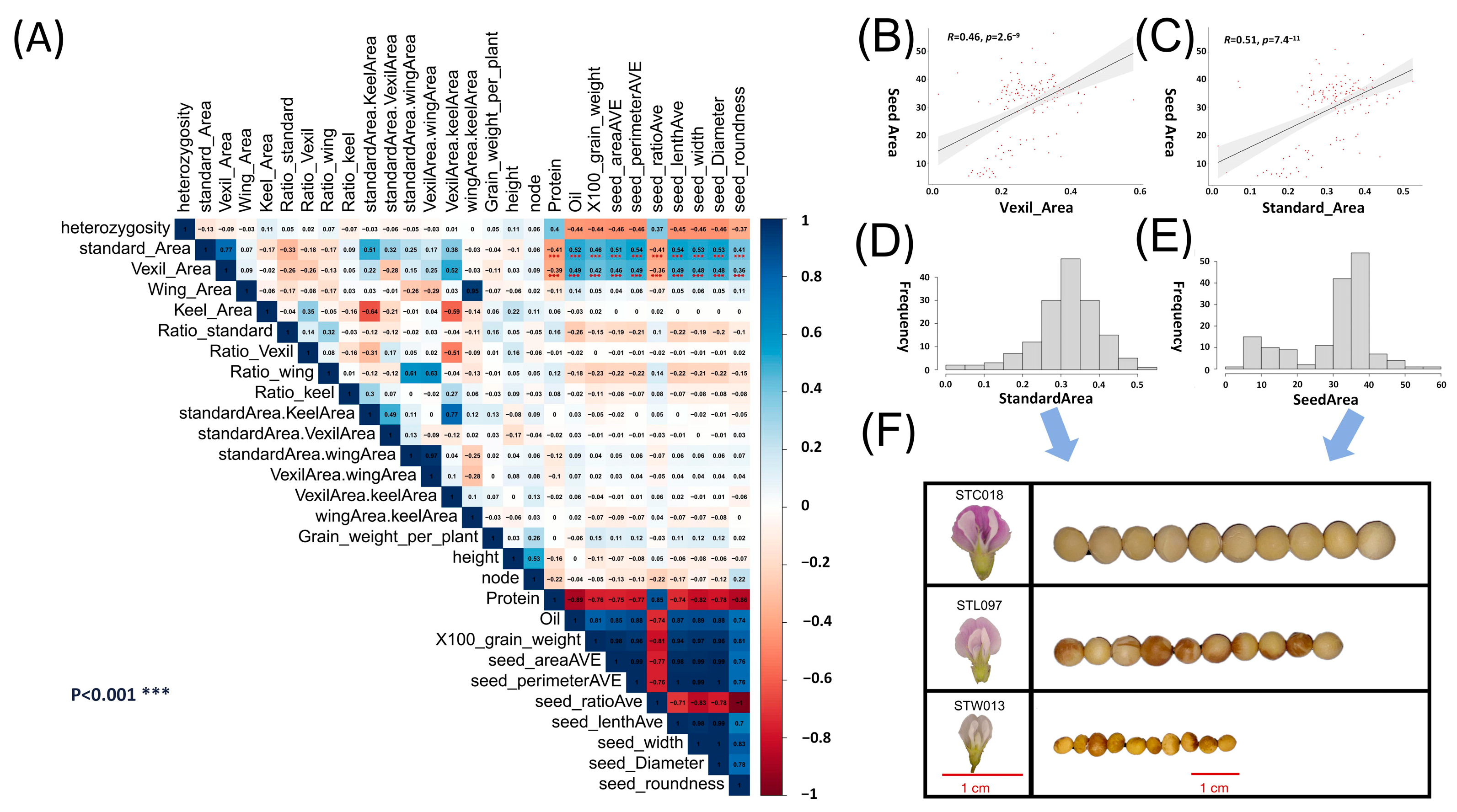

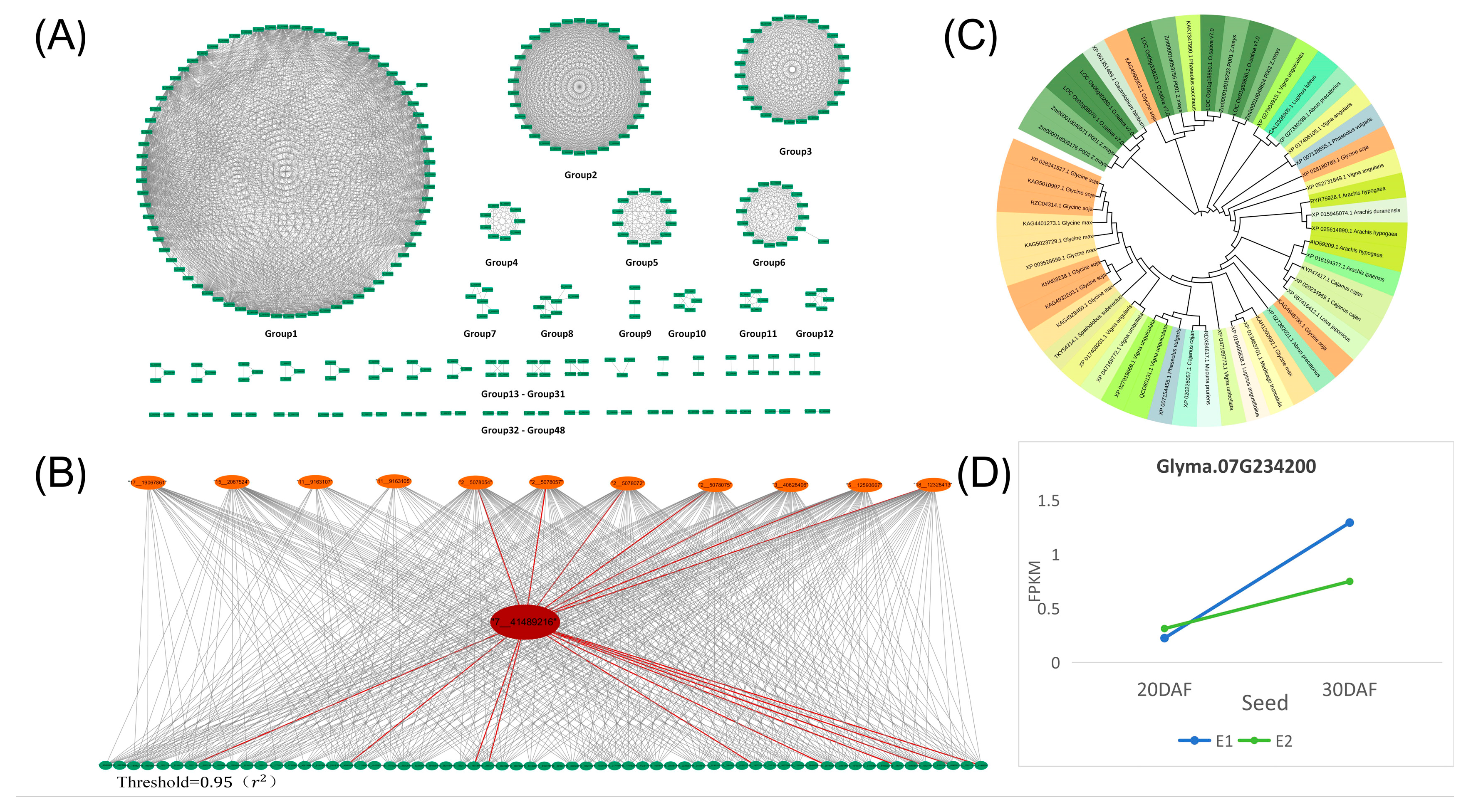
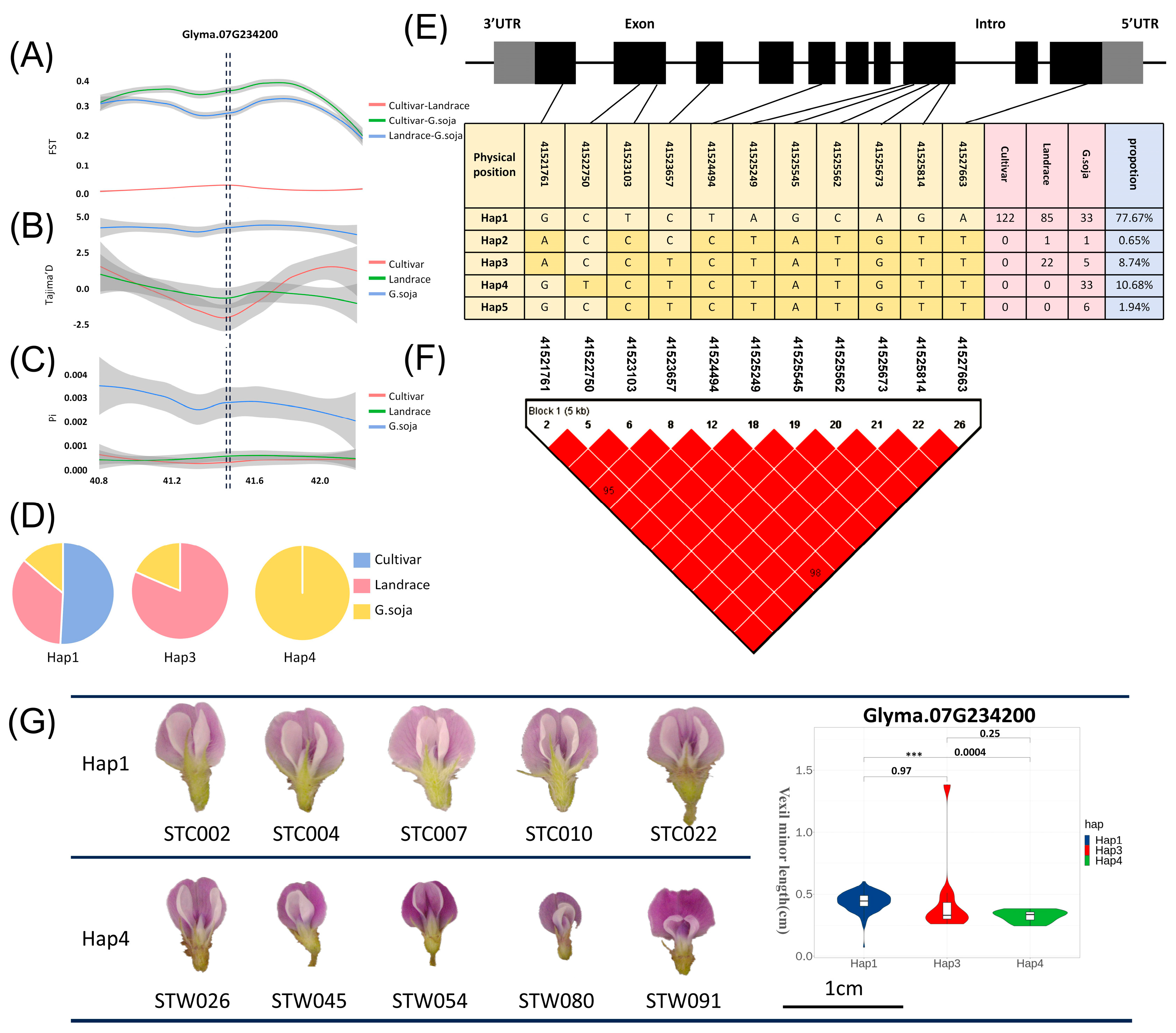
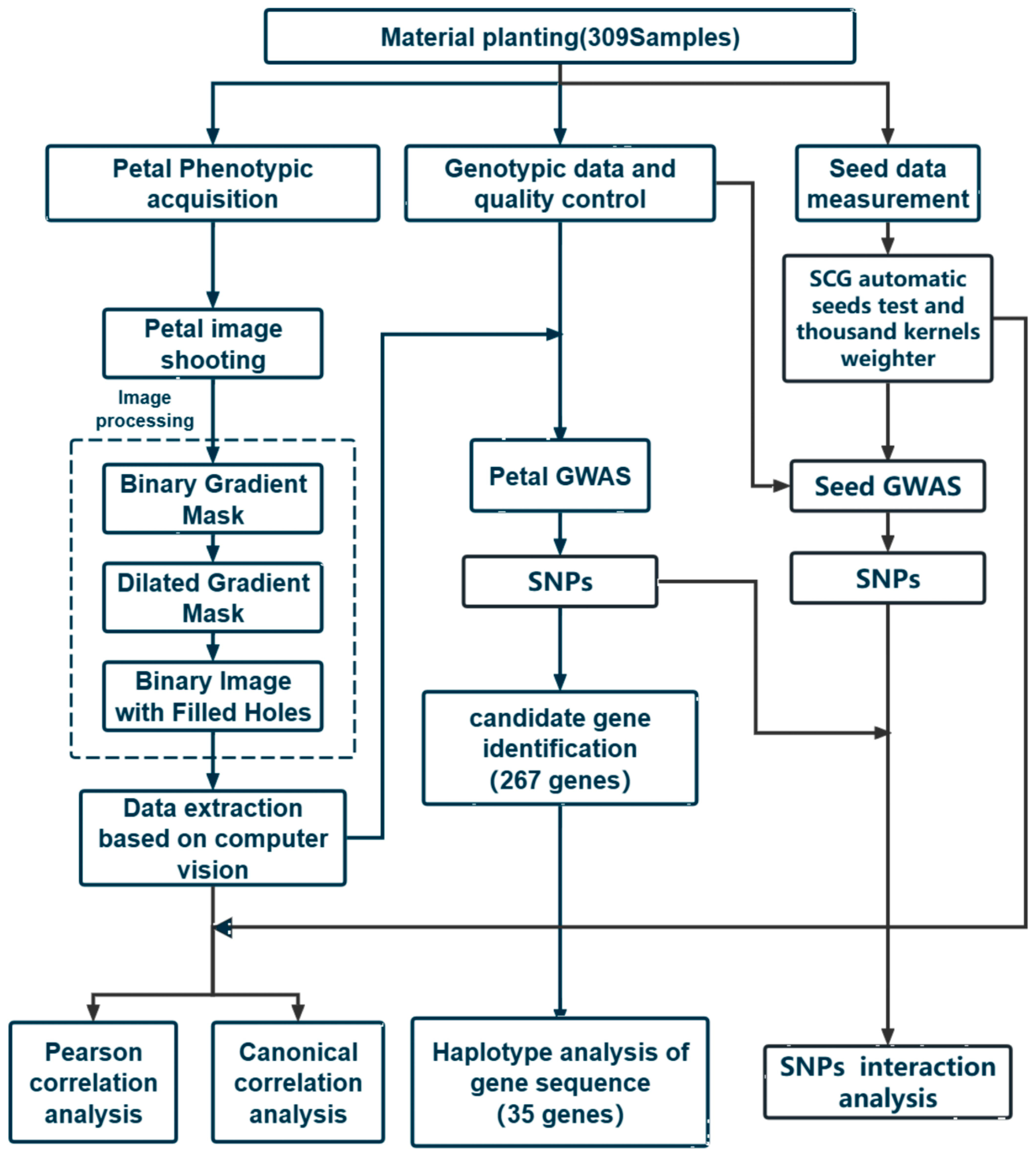
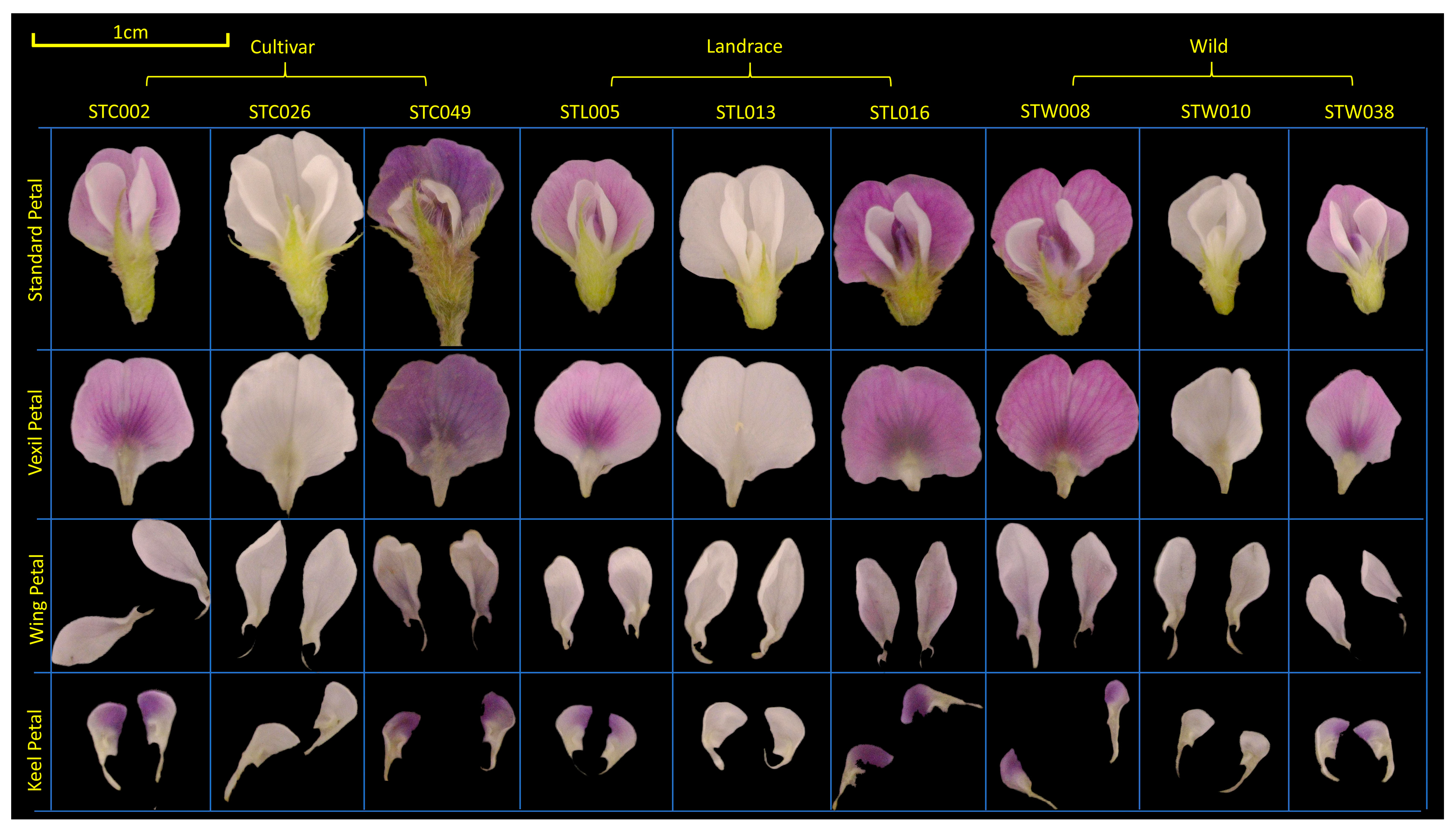
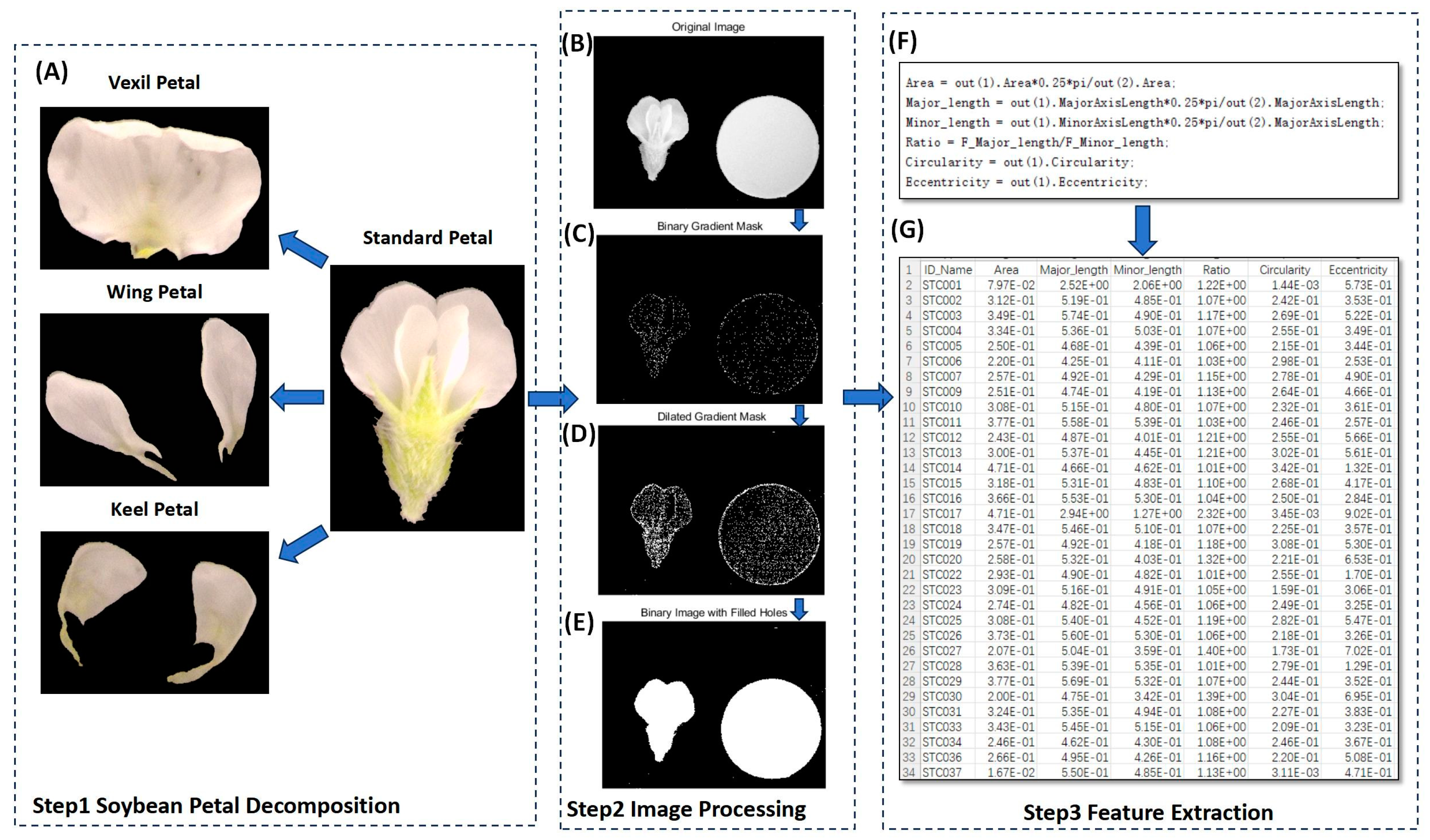
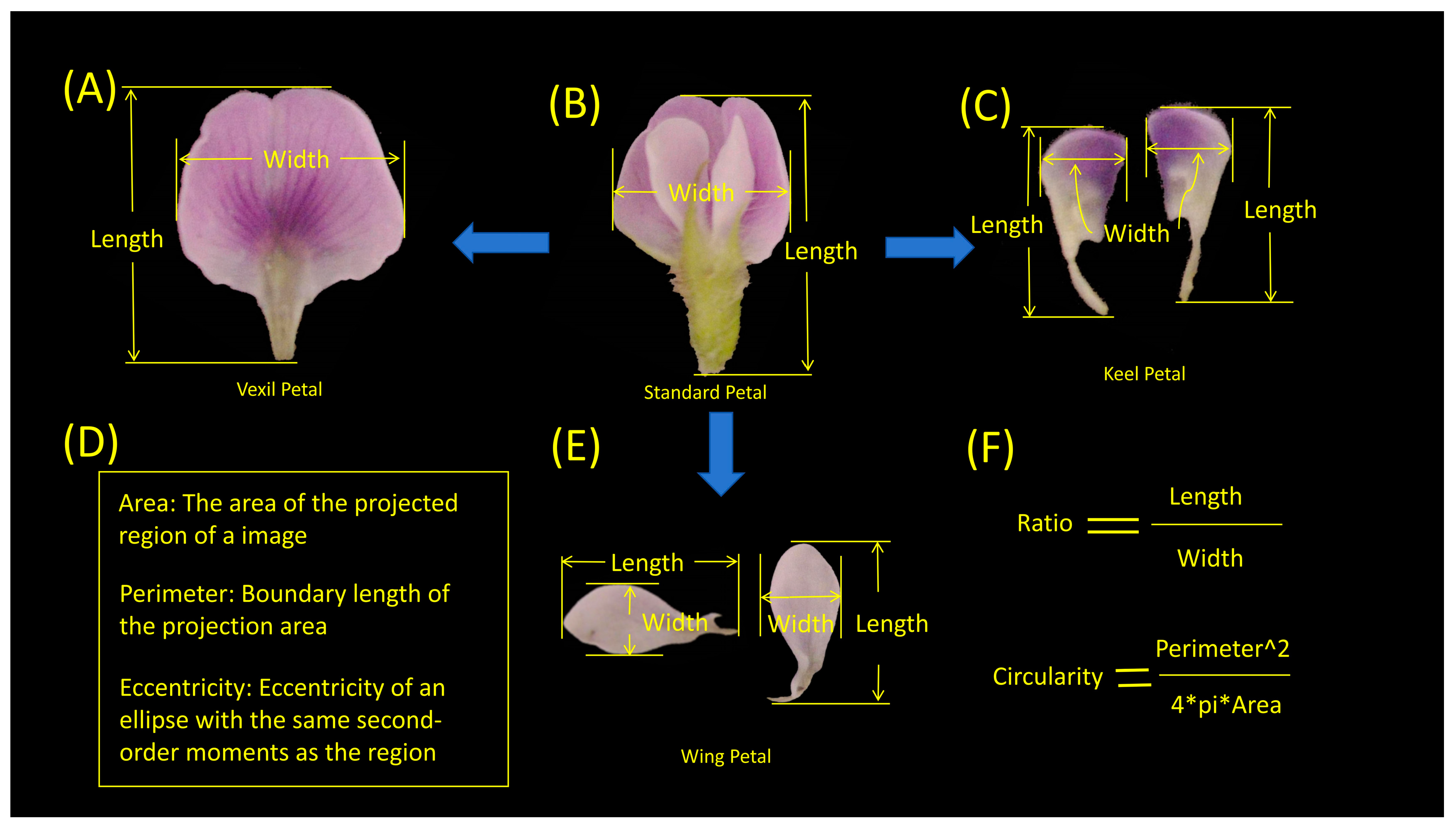
| Phenotype | Gene ID | Gene Segment Haplotype Significance | CDS Segment Haplotype Significance |
|---|---|---|---|
| Vexil major length | Glyma.07G231600 | Yes | Yes |
| Glyma.07G231800 | Yes | Yes | |
| Glyma.07G231900 | Yes | No | |
| Glyma.07G232000 | Yes | Yes | |
| Glyma.07G232300 | Yes | Yes | |
| Glyma.07G232400 | Yes | Yes | |
| Glyma.07G232500 | Yes | Yes | |
| Glyma.07G233300 | Yes | Yes | |
| Glyma.07G233400 | Yes | Yes | |
| Glyma.07G233500 | Yes | No | |
| Glyma.07G233900 | Yes | Yes | |
| Glyma.07G234000 | Yes | Yes | |
| Glyma.07G234100 | Yes | Yes | |
| Glyma.07G234200 | Yes | Yes | |
| Glyma.07G234500 | Yes | Yes | |
| Glyma.07G234800 | Yes | Yes | |
| Glyma.07G234900 | Yes | Yes | |
| Glyma.07G235000 | Yes | Yes | |
| Glyma.07G235200 | Yes | No | |
| Glyma.07G235400 | Yes | No | |
| Glyma.07G235500 | Yes | Yes | |
| Glyma.07G234300 | Yes | Yes | |
| Vexil minor length | Glyma.07G231600 | Yes | Yes |
| Glyma.07G231800 | Yes | Yes | |
| Glyma.07G231900 | Yes | No | |
| Glyma.07G232000 | Yes | Yes | |
| Glyma.07G232200 | Yes | Yes | |
| Glyma.07G232300 | Yes | Yes | |
| Glyma.07G232400 | Yes | Yes | |
| Glyma.07G232500 | Yes | Yes | |
| Glyma.07G232800 | Yes | Yes | |
| Glyma.07G233300 | Yes | Yes | |
| Glyma.07G233400 | Yes | Yes | |
| Glyma.07G233600 | Yes | Yes | |
| Glyma.07G234200 | Yes | Yes | |
| Glyma.07G234500 | Yes | Yes | |
| Glyma.07G234800 | Yes | Yes | |
| Glyma.07G234900 | Yes | Yes | |
| Glyma.07G235000 | Yes | Yes | |
| Glyma.07G235200 | Yes | No | |
| Glyma.07G235400 | Yes | No | |
| Glyma.07G235500 | Yes | Yes | |
| Wing minor length | Glyma.18G043700 | Yes | Yes |
| Glyma.18G045700 | Yes | Yes | |
| Glyma.18G046000 | Yes | No | |
| Glyma.18G047900 | Yes | No | |
| Glyma.18G276800 | Yes | Yes | |
| Glyma.18G277400 | Yes | Yes | |
| Glyma.18G278600 | Yes | No | |
| Glyma.18G277800 | Yes | Yes | |
| Glyma.18G278900 | Yes | Yes | |
| Glyma.18G280700 | Yes | Yes |
Disclaimer/Publisher’s Note: The statements, opinions and data contained in all publications are solely those of the individual author(s) and contributor(s) and not of MDPI and/or the editor(s). MDPI and/or the editor(s) disclaim responsibility for any injury to people or property resulting from any ideas, methods, instructions or products referred to in the content. |
© 2024 by the authors. Licensee MDPI, Basel, Switzerland. This article is an open access article distributed under the terms and conditions of the Creative Commons Attribution (CC BY) license (https://creativecommons.org/licenses/by/4.0/).
Share and Cite
Jin, S.; Tian, H.; Ti, M.; Song, J.; Hu, Z.; Zhang, Z.; Xin, D.; Chen, Q.; Zhu, R. Genetic Analysis of Soybean Flower Size Phenotypes Based on Computer Vision and Genome-Wide Association Studies. Int. J. Mol. Sci. 2024, 25, 7622. https://doi.org/10.3390/ijms25147622
Jin S, Tian H, Ti M, Song J, Hu Z, Zhang Z, Xin D, Chen Q, Zhu R. Genetic Analysis of Soybean Flower Size Phenotypes Based on Computer Vision and Genome-Wide Association Studies. International Journal of Molecular Sciences. 2024; 25(14):7622. https://doi.org/10.3390/ijms25147622
Chicago/Turabian StyleJin, Song, Huilin Tian, Ming Ti, Jia Song, Zhenbang Hu, Zhanguo Zhang, Dawei Xin, Qingshan Chen, and Rongsheng Zhu. 2024. "Genetic Analysis of Soybean Flower Size Phenotypes Based on Computer Vision and Genome-Wide Association Studies" International Journal of Molecular Sciences 25, no. 14: 7622. https://doi.org/10.3390/ijms25147622







